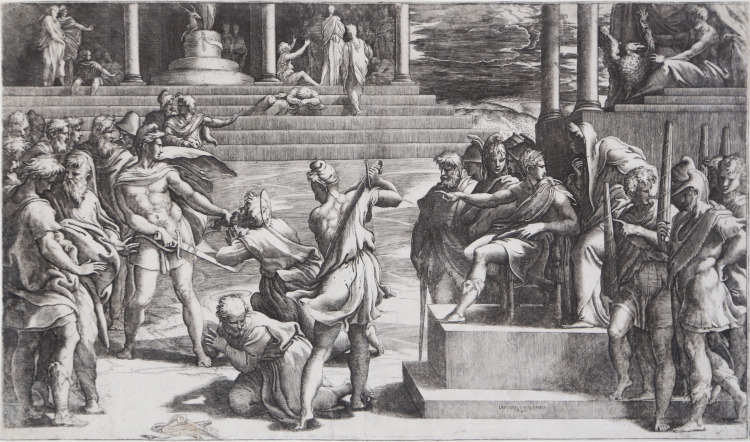




| Reference: | S47106 |
| Author | Gian Jacopo CARAGLIO |
| Year: | 1525 ca. |
| Measures: | 455 x 260 mm |



| Reference: | S47106 |
| Author | Gian Jacopo CARAGLIO |
| Year: | 1525 ca. |
| Measures: | 455 x 260 mm |
The martyrdom of Sts Peter and Paul set within a classical edifice, both kneel and the executioner raises his sword.
Engraving, circa 1525/27, lettered on step at lower right 'Jacobvs Parmensis / Fecit.' After Parmigianino.
Example in the first state of three described by Cirillo Archer (The Illustrated Bartsch, p. 96), before the address of Antonio Salamanca. Further editions from the De Rossi Family are known, but are not described in the literature.
Beautiful proof, rich in tones, printed on contemporary laid paper without watermark, printing defects on the left side of the plate, minimal abrasions visible on the reverse, otherwise in good condition.
The print reproduces, in reverse, a drawing by Parmigianino preserved in the British Museum. According to Gnann, this is the first proof of the collaboration between Parmigianino and Caraglio.
Bibliografia
Bartsch XV.71.8; TIB 28.85.8, I/III; A.E. Popham 190; Gnann 256; TIB 28 Comentary 96.8; M.Mussini, G.M. De Rubeis, Parmigianino tradotto, 75.
Gian Jacopo CARAGLIO (Verona 1505 - Cracovia 1565)
|
Giovanni Jacopo Caraglio or Caralio, Caral, Caralius, was a copper engraver, gem cutter, goldsmith and maybe even architect, according to Vasari. Caraglio was born approximately in 1505, in Verona or Parma, that is the reason why he often refers to himself as Veronensis or Parmensis. Because of the Sack of Rome he was obliged to leave unfinished his Ratto delle Sabine (The Rape of the Sabine Women), after a drawing of Rosso Fiorentino. He moved to Venice, were he worked until 1537.
While in Rome, he worked for Baviera, realizing in 1562 Dei dell’Olimpo, Fatiche di Ercole and Amori degli Dei, all after Rosso’s drawings, his favourite artist, together with Baldinelli and Parmigianino. While in Venice, on the contrary, he worked on subjects from Titian.
He moved to Poland in 1539 and started spreading the graphic art of Marcantonio in the Eastern Countries.
On July the 3rd, 1545, he joined the Court of Siegmund II, with an annual salary of 60 florins, till the death of the King in 1548; he afterwards worked for King Siegmund II Augustus as goldsmith and gem cutter. In 1552 he’s said to be working in Vilna, in Lithuania, the second capital city of the kingdom where the Court had temporarily moved. He went back and forth from Italy to Lithuania untill he died, on August the 26th, 1565.
Bartsch has listed 65 engravings belonging to Caraglio; Le Blanc has added other four subjects.
|
Gian Jacopo CARAGLIO (Verona 1505 - Cracovia 1565)
|
Giovanni Jacopo Caraglio or Caralio, Caral, Caralius, was a copper engraver, gem cutter, goldsmith and maybe even architect, according to Vasari. Caraglio was born approximately in 1505, in Verona or Parma, that is the reason why he often refers to himself as Veronensis or Parmensis. Because of the Sack of Rome he was obliged to leave unfinished his Ratto delle Sabine (The Rape of the Sabine Women), after a drawing of Rosso Fiorentino. He moved to Venice, were he worked until 1537.
While in Rome, he worked for Baviera, realizing in 1562 Dei dell’Olimpo, Fatiche di Ercole and Amori degli Dei, all after Rosso’s drawings, his favourite artist, together with Baldinelli and Parmigianino. While in Venice, on the contrary, he worked on subjects from Titian.
He moved to Poland in 1539 and started spreading the graphic art of Marcantonio in the Eastern Countries.
On July the 3rd, 1545, he joined the Court of Siegmund II, with an annual salary of 60 florins, till the death of the King in 1548; he afterwards worked for King Siegmund II Augustus as goldsmith and gem cutter. In 1552 he’s said to be working in Vilna, in Lithuania, the second capital city of the kingdom where the Court had temporarily moved. He went back and forth from Italy to Lithuania untill he died, on August the 26th, 1565.
Bartsch has listed 65 engravings belonging to Caraglio; Le Blanc has added other four subjects.
|